One of the most mysterious creatures around is finally having its cover blown.
Researchers at the Chippewa Prairie in Minnesota are using radio telemetry to provide a better picture of the lives of one of the most secretive and little-known creatures of grasslands: the plains hog-nosed snake (also known as the western hog-nosed snake).
The study is part of a larger effort to document the effects of patch-burn grazing, an innovative conservation grazing technique I covered in a previous Cool Green Science post. Researchers are monitoring various wildlife to see how the species respond to the burning and grazing regime on the prairie.
As Dave Trauba, wildlife manager for Minnesota’s Department of Natural Resources, says, ““If it wiggles, crawls or flies, and lives on the prairie, we have someone studying it.”
One of those species is the plains hog-nosed snake (Heterodon nasicus), a snake with some highly unusual ways of scaring and tricking its enemies.
Radio tracking them at Chippewa Prairie has also revealed new behavior, never before documented in the literature.
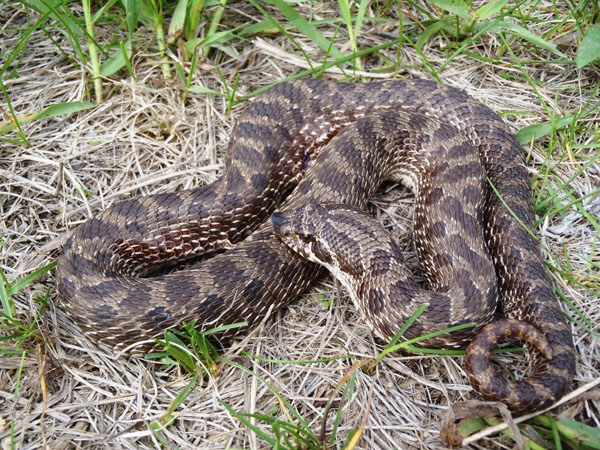
Meet the Hog-nosed Snake
The four species of North American hog-nosed snakes (genus Heterodon) all share the upturned nose that give them their name. They can use this to aid in burrowing – they’re one of the few North American species that can dig their own.
They’re also a fairly stout snake, so they can’t slither away as quickly as some more slender species, like the plains gartersnake. So the hog-nosed snakes can’t just dart away at approaching danger.
Instead, when confronted with a threat, the hog-nosed snake first spreads its neck out and flattens its head, appearing similar to a cobra. It accents this with a loud hiss.
“For most people, that’s more than enough,” says Jeff LeClere, the herpetologist for Minnesota DNR leading this study. “They see a snake that looks like a cobra, and they’re headed in the opposite direction.”
But the hog-nosed snake’s bark is literally worse than its bite. LeClere says the snake will rarely, if ever, attempt to bite someone while in this state, even if it is picked up.
It instead takes a different route. “If you keep harassing them, they’ll rapidly writhe around on the ground, almost in a figure eight,” says LeClere.
And then, a final act: the hog-nosed snake turns over on its back, sticks its tongue out and ceases all movement. It is essentially playing dead.
“There’s almost nothing you can do to make them move in this state,” says LeClere. “You can pick them up and they will remain in position. But if you flip them over, they immediately flip onto their back and resume the act.”

You might assume that a snake given to such dramatic displays would be easy to find, particularly in open grassland. Not so. In fact, the radio telemetry research at Chippewa Prairie began because researchers were having a tough time studying the species.
LeClere had been monitoring reptiles and amphibians by putting sheets of plywood and tin around Chippewa Prairie. Reptile and amphibian species use this cover for warmth and concealment, and researchers can get an idea of the abundance and diversity of species on the prairie.
But hog-nosed snakes use their own burrows – or those dug by mammals like pocket gophers – and so they don’t use the cover constructed by researchers.
LeClere did search for the snakes following burns, when they’re easier to find in the shorter grass. But they still were having trouble finding many of this species.
“Are these snakes really rare, or are they just really good at hiding?” asks LeClere.
That was one of the questions to be answered by his research, research that would provide some surprising insights about this species.
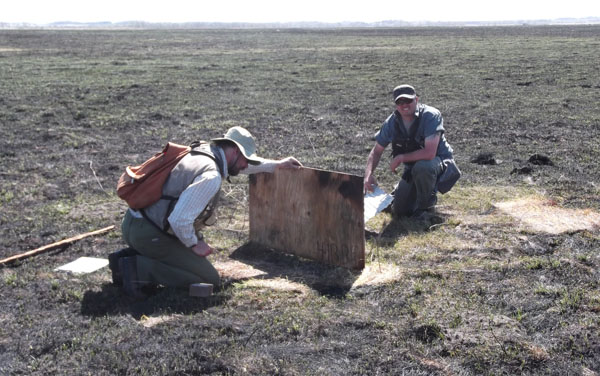
Snakes Lead to Snakes
LeClere found two plains hog-nosed snakes following the burn – not as many as he hoped, but it proved to be enough to launch the research effort. Both snakes were fitted with radio transmitters, allowing researchers to periodically check their locations on the prairie.
It also led the researchers to more hog-nosed snakes. “Basically, the snakes led us to more snakes,” says LeClere.
Hog-nosed snakes are mostly solitary, but some do hibernate together. Tracking the snakes to their winter den site – known as a hibernaculum – enabled researchers to track more snakes.
It turns out that the snakes were really good at hiding. Often, they burrowed down into the base of prairie grasses, making them almost impossible to see. Their puffing, hissing and death faking mark a rather desperate last resort, only after evasion has failed.
“They are very, very good at staying out of sight,” says LeClere. “Even if you step on one of these snakes, I firmly believe it wouldn’t move.”
In all, seven snakes were fitted with transmitters. Additionally, all snakes captured were given a PIT tag, a tag that can’t be radio tracked but can be scanned by researchers for the life of the snake.
Are these snakes really rare, or are they just really good at hiding?
Jeff LeClere
The snakes were weighed and measured, and two scales were collected to provide information on the genetics of the animals. (Collecting a scale is as harmless as clipping a human fingernail).
This provides a substantial amount of data on the plains hog-nosed snake population at Chippewa Prairie. That in itself is incredibly useful for conservationists. But tracking the snakes provided even more valuable information – including never-before-recorded hog-nosed snake behavior.
Researchers use an antenna and receiver to detect snakes from 400 to 500 meters away. During the first year of the study (in 2013), LeClere was tracking three female snakes across the prairie.
“They had laid their eggs and were using the prairie normally,” says LeClere. “They were hunting the ridges and flat part of the prairie, resting, using the burrows.”
This was all to be expected. Plains hog-nosed snakes were thought to be terrestrial species, meaning they mainly stayed in drier prairie environments. They might make a brief foray into a marsh, but that was not a place they’d go for extended periods.
The radio-tagged hog-nosed snakes apparently did not read that literature.
The first snake disappeared, with researchers unable to get her signal. Then the researchers found the second snake going into a cattail marsh, well out into the water.
The researchers were able to follow the third snake into the marsh incrementally. All three snakes stayed in the marsh for at least one month, with one staying there for three months. They lived on the tops of dense cattails, preying on frogs.
Was this an anomaly? An important hint for conserving the species? Or an adaptation to patch-burn grazing?
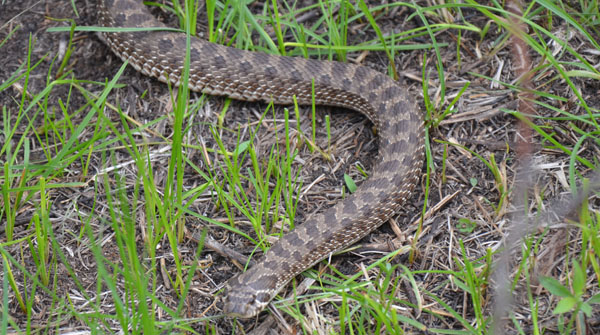
Big Snake on the Prairie
It’s too soon to understand why these hog-nosed snakes went into the marsh. This year, the tagged snakes did not exhibit this behavior, sticking instead to more typical prairie and upland habitat, with only brief forays into the marsh.
LeClere is fairly certain the snakes didn’t go there for food – the frogs preferred by snakes are equally common in grass and marsh habitats.
One speculation is that the marsh is where plains hog-nosed snakes go to escape the cattle and fire of patch-burn grazing.
“There is the possibility this [behavior] is an adaptation to fires and large herds on the prairie,” says LeClere. “Perhaps we haven’t seen it before because it’s been a while since we’ve had burning and grazing here. But we really need to gather more data.”
And that’s a big focus at Chippewa Prairie, with connecting properties owned by The Nature Conservancy and the Minnesota DNR. They are testing the idea that patch-burn grazing increases diversity – not only of grasses, but of a variety of wildlife species, too.
The hog-nosed snakes will hopefully be studied for 10 years, providing a much clearer picture on how this grazing technique affects their behavior and population.
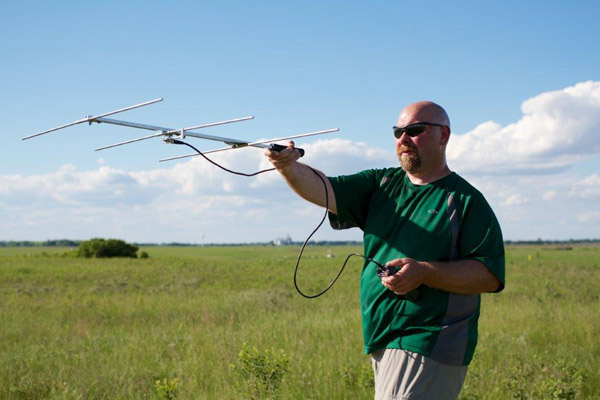
“There are elements of patch-burn grazing that can have direct impacts on individual snakes,” says LeClere. “We had one of our tracked snakes that got trampled by cows, and a couple of snake fatalities from burning. But overall, it will probably help the snake population.”
LeClere believes a long-term study will not only serve to monitor snakes, but also better conserve them.
“My hope is that this leads to better management,” he says. “There may be easy ways to manage the fire and cows to benefit the snakes.”
And conserving snakes on the prairie might mean looking beyond the prairie.
“We might have guessed that to conserve hog-nosed snakes, you just had to focus on grasslands and uplands,” says LeClere. “But what we’re seeing suggests not only is the prairie important, but the cattail marsh is, too. Water quality and integrity is almost as important as keeping land intact. The more data we collect, the better we’ll be able to see the big picture – and manage this prairie to benefit a diversity of plants and animals.”
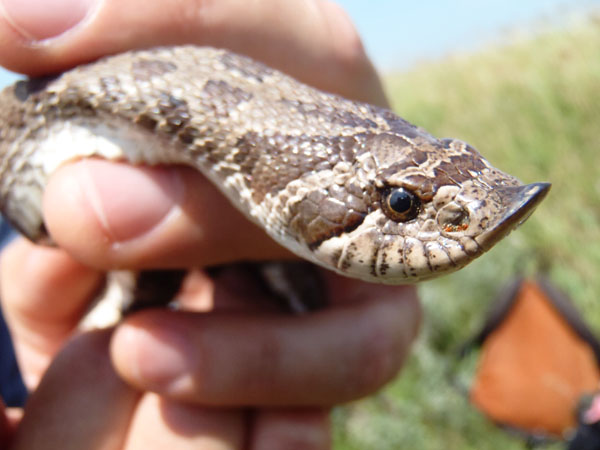



One of my dogs came up on one of these and it did come up like a cobra, scared me more than the dog but I did manage to get the dog away. I learned what it was from the snakeman on facebook. I live in the Stacy, MN area. It was nice to know they aren’t very aggressive. I always have to brush over my tiger lillies before I start cleaning up around them or I’ll get quite a scare!!! Nice article, thanks for the info!
What sex were the tracked snakes that went into the wetland?
I have never seen an hog nose snake. Thanks for the picture and the information.
When I was a child some 65 years ago or longer in east Texas, we had a lot of snakes—a lot more than we do now, as many of them are no longer found and may even be extinct in the locale, but the hog-nosed snake we called—get this, a “spred’n adder.” They were fairly common, but I haven’t seen one since. Very sad to me; thanks for showing that they are alive somewhere.
Thanks for an informative article as well as your conservation and protection of these wonderful reptiles.